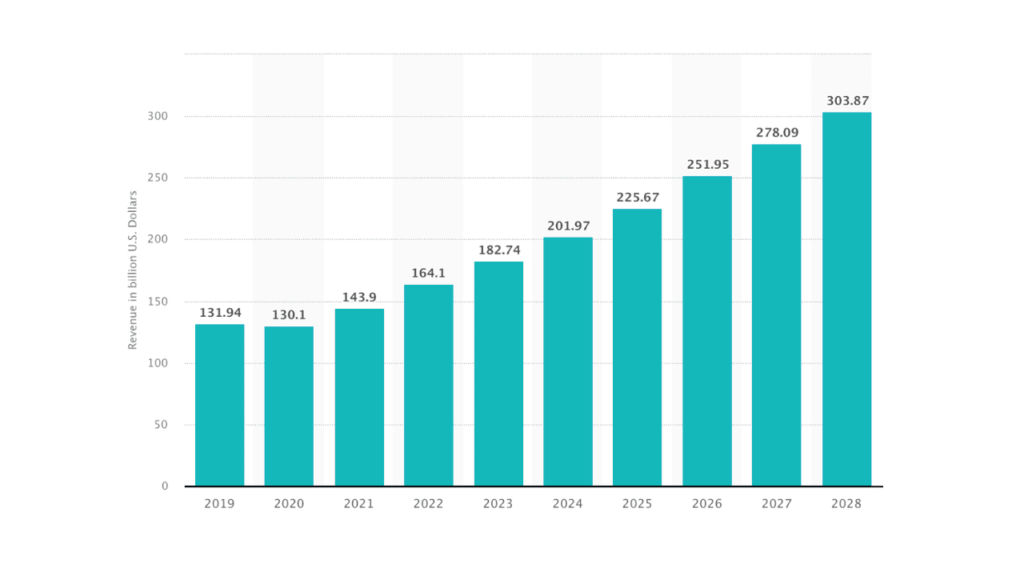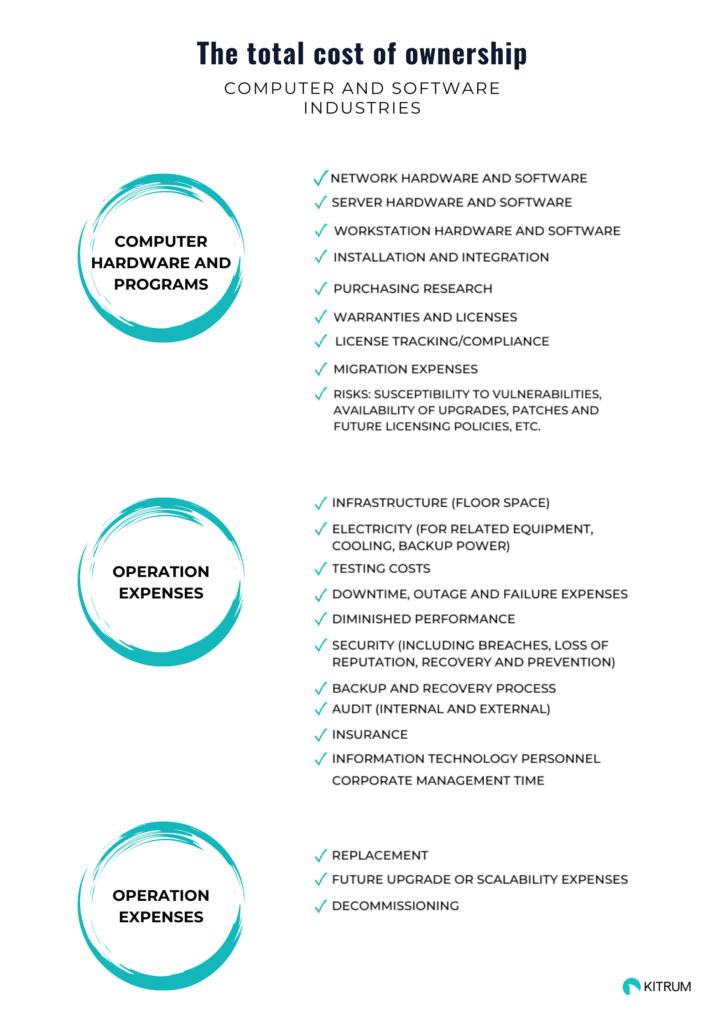Do you always pay more when you outsource software development? What is the average cost of custom software development? How to calculate total cost of ownership for software? — Explore the article to figure it out.
According to Coachbase, the cost of developing a complex app starts from USD 30,000. This price can vary depending on the complexity of the software and even reach the millions for the most advanced apps. Organizations frequently need to learn the total cost before the app development process. Calculating your project’s TCO (Total Cost of Ownership) is an excellent way to predict cost-effectiveness. The TCO directly impacts the ROI (Return on Investment) because it determines the profitability of a project over a set period. Therefore, you must first determine the TCO to calculate the ROI correctly.
When creating enterprise software, teams consider only certain costs while ignoring others, such as the scope of work for custom software development, developer recruitment stages, and QA processes undergone during testing, operation, and maintenance throughout the SDLC. However, they are all accrued as hidden costs.
It is also important to remember that TCO can fluctuate over time. It might be higher at first due to the need for training, but it will eventually fall as the costs of servicing and support change, increasing the risk of failure and associated downtime. If you have trouble figuring it out, we’ll walk you through the main steps and factors of custom enterprise software price estimation.
What is the meaning of total cost of ownership?
The total cost of ownership software (TCO) includes all costs of designing a product or service throughout the development life cycle. These expenses are related to the planned IT solution both directly and indirectly. Direct expenditure, for instance, includes fees for hiring and administration, and indirect costs could be the downtimes.
The difference between running costs and capital expenditure is an essential factor when calculating the total cost of ownership of a system. TCO cost measurement allows you to uncover the total costs of a given IT system and the overheads of changed components.
What is an example of total cost of ownership?
Let’s look at three real-life examples to clarify the total cost of ownership software: investing in a banking solution, getting proprietary software, and renting an apartment. Through these practical scenarios, we’ll uncover the multifaceted nature of TCO and its applicability across diverse domains.
TCO example in the finance industry
Investing in a banking solution is one example. You’ll need to conduct a thorough analysis of the total cost of ownership. Of course, the base cost of software development is taken into account, but what are other development costs? There are additional expenses to consider:
- Recruitment: costs of job posting, agencies, hiring events, HR, developers’ salaries, interviews, and hiring tools;
- Testing: costs of performing functional and non-functional testing;
- Maintenance: costs of future upgrades, retesting, debugging, etc;
- Miscellaneous: any unforeseen expenses that may arise.
Using these costs as a guide, you can calculate the benefits and drawbacks of developing custom software versus purchasing off-the-shelf systems. You can also predict the overall success of your project, whether on an ongoing or future basis. Finally, product owners use the TCO to make purchasing decisions on a smaller scale.
Software purchasing as a TCO example
As one more example, think about a global brand like Google. They decide to get proprietary software to enhance their services and products, which comes with a $10,000 price tag. But, before going ahead, Google evaluates the total cost of their financial choice from buying to getting rid of it. Initially, the purchase might be $1,000,000, but there are extra expenses tied to training, setup, repairs, and more that need to be taken into account.
Because of a flaw in the business analysis, the company will have to cover an additional cost of $900,000 regardless of whether they knew the complete purchase decision cost from the start. If the company can’t consider the entire cost, its operations will be negatively affected.
Understanding the total cost of ownership is critical because it allows owners to make better financial decisions. As a result of sound cost-cutting policies, businesses can avoid unforeseen expenses that they could not account for and improve their profitability and efficiency.
TCO example in the Real estate business
Another example of the Total Cost of Ownership is renting an apartment. While the upfront fees are readily available, you may be required to pay for various other items. Assume the apartment requires you to pay for the insurance. That is only one side of the coin. You’ll also need to consider things like:
- expenses of moving from your previous residence to your new home;
- agency commissions;
- security fees.
Breaking TCO costs in software development outsourcing

The IT-outsourcing market was expected to generate 164.1 billion US dollars in revenue in 2022. The IT-outsourcing market is expected to be worth approximately 303.87 billion US dollars by 2028. While more businesses are joining the bandwagon, the success of any outsourcing project is heavily reliant on strategic planning. And the TCO plays a significant role in this.
Therefore, the decision to outsource the development of custom software is frequently based on reducing costs by comparing and contrasting the efforts of expensive and affordable software development teams. It is prudent to be aware that the cost of outsourced software operation may increase exponentially due to factors that a business may or may not be familiar with, and these factors that may affect outsourced software development are as follows:
- risk;
- integrity;
- efficiency;
- method.
Risk
The sheer number of failures in the execution of software development is one key factor that drives businesses to hire a costly software team that prioritizes the success of business operations over anything else. Well-paid services result in the best services rendered, and this is the motivation for business decisions, as opposed to taking the risk of hiring an incompetent software team that will commit to shoddy work and stall the business operation.
Integrity
The integrity of the business software is an important consideration for a business because it is frequently more expensive to account for the debt caused by bug-ridden software when this could easily be avoided by hiring an expensive team that is very competent and thus giving the business tangible cost benefits.
Efficiency
According to industry standards, the quality of output from an expensive hire is more than ten times that of a cheap hire. Because resources are limited, it is preferable to go with the proven efforts of an expensive hire to avoid wastage and double allocation of resources.
Method
The benefits of a well-oiled team often boil down to the ability to collaborate effectively within the team. The conduciveness of a business environment for work is critical to improving the business’s outcome-to-work ratio, timely delivery of tasks, cost of idle pay, and so on. These advantages are associated with the services of expensive hire, as opposed to cheap hire.

How much does it cost to hire a team of software developers?
Hiring software developers can be costly, and the key is to ensure that the benefits of finding top talent outweigh the expenses. A recent study highlights a significant gap between the supply of skilled software developers and the demand for their services, with businesses typically taking a minimum of 42 days to secure a high-quality agency. To ensure the process of recruitment is done tactfully, these are the due considerations businesses should go through:
- Finding the right agency;
- Recruitment cost;
- Efficiency cost.
Finding the right agency
Considering the question, “Which is the best way to hire a software developer?” businesses are encouraged to take due consideration in choosing an agency for their software projects. The choice of the right software agency means a similar cultural identity and process between the vendor and the business.
A choice of the right information technology agency means all expenses incurred by the vendor are optimized, and the service delivered enhances communication and collaboration within the business. The cost of finding the right agency for software projects is often within 15% to 30% of the annual pay for the services of the IT agency.
Recruitment cost
This cost comprises the expenses used in processing the vetting of the software developers to work with, the consultation, training, and induction. These four stages make up the cost of recruitment as it takes a toll on a business to expand its resources in finding the right business-to-team fit.
This stage costs more as there is the dedication of special resources that could otherwise be used elsewhere to ensure that the business operations are always a going concern.
Efficiency cost
The loss due to efficiency occurs as a result of a stall in business operations due to positions being left vacant that should otherwise be occupied. The zero productivity of the open position means the business is not producing optimally.
This cost is often overlooked when analyzing the business turnover, but concrete research indicates that it is a bad business decision to leave a position vacant, as it hurts businesses in ways that are hidden yet significant, similar to how a firm total cost of ownership considerations should not only account for costs that can be felt initially but inclusive of costs that are great, and seemingly invisible.
What about the operating expenses?
The operational cost of software development for a business is the cost function of a business information technology division that shows the activities that make up the business expenses, and here are some of these activities below:
- Assembly of technical requirements;
- Environment establishment;
- Developers recruit across all levels for a business fit;
- Management of the legal, financial, and environmental work for developers.
Assembly of requirements
This process forms a core aspect of a business’s operational costs. It addresses questions related to project expectations, objectives, and activities, along with outlining approaches for requirements tracing, analysis, and storage.
These activities under the assembly of requirements are key because it guides the running of the project from the start to the end, as it goes through filtering activities that are essential from the non-essential activities that aid software development. Each software development project is driven by a purpose, a methodology to achieve that purpose, and an intended outcome. This steers the software development team and streamlines coordination throughout all necessary steps, culminating in a high-quality end result.
Setting up the environment
When developing an application, you need to consider the cost of different environment setups depending on the development stage. It would include the cost of establishing:
- development environment;
- beta environment;
- production environment.
The development environment is where developers create your application and finish the coding process. They usually set up the development environment on their local PCs and use a Git repository to help with their work. The beta environment comes into play once the developed software product is prepared for release. The primary purpose of the beta stage is to test the software, but it’s not the only goal. This stage incurs costs for both developer and product testing by actual users. The final environment configuration is the production environment. At this point, the software is ready to be launched, but it’s crucial that thorough testing has been conducted before going live.
Developers recruitment across all levels for a business fit
Organizations look for applicants who will readily fit in during the hiring process. Therefore, costs of training, creating a recruitment policy, active search and screening, applicant testing, and onboarding new entrants are incurred to accomplish this. Allocating a portion of your budget to hiring streamlines the process for both recruiters and candidates. It ensures that if applicants are hired, they will perform effectively and maintain high productivity.
The management of the legal, financial, and environmental work for software developers
Managing developers effectively guarantees timely compensation and smooth work execution while ensuring a violation-free working environment. This principle extends to the developer’s workspace. A favorable environment, regardless of the cost, consistently yields higher turnover compared to a poorly supervised setup aimed at cutting business expenses. The end for most businesses is to minimize costs as much as possible and make revenue as high as feasible.
Conclusion
Understanding the total cost of ownership holds immense importance, as analyzing it acts as a safeguard against potential future losses. Instead of fixating solely on immediate direct costs, businesses can make informed decisions that enhance their financial strategies. Embracing this comprehensive perspective empowers organizations to navigate investments with foresight, promoting not only economic prudence but also long-term resilience and prosperity.







